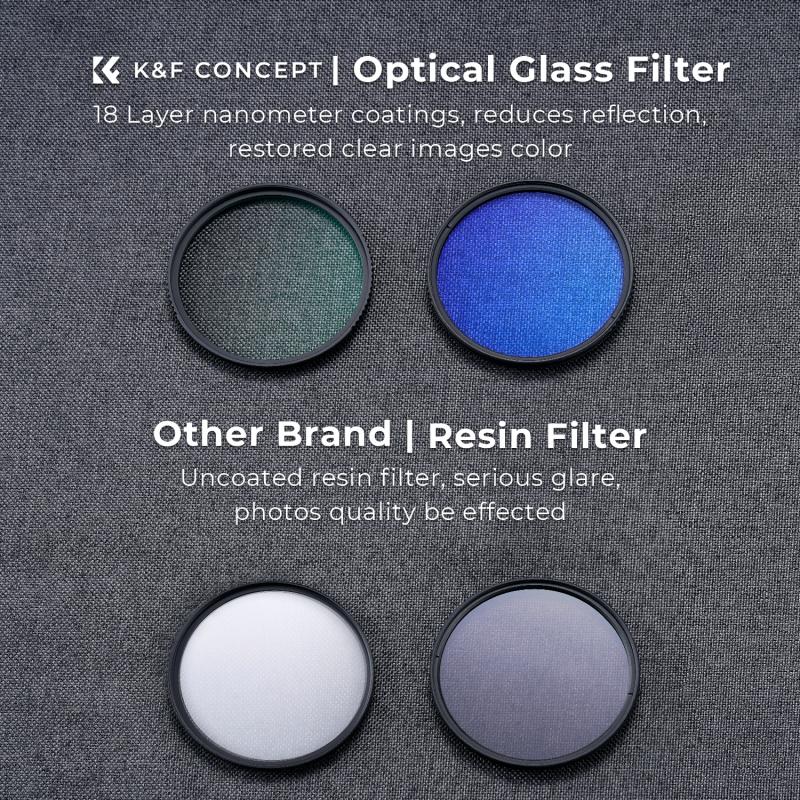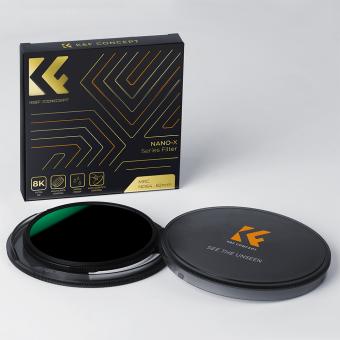Polarizing Filter How It Works ?
A polarizing filter is an optical device that selectively blocks certain polarized light waves from passing through, based on their orientation. It consists of a material that contains long, parallel molecules that act as tiny slits or openings. When unpolarized light passes through the filter, the molecules align themselves in a way that allows only light waves with a specific polarization orientation to pass through, while blocking or reducing the intensity of light waves with other orientations. This process is known as polarization.
The filter is commonly used in photography to reduce glare and reflections from non-metallic surfaces such as water or glass. By rotating the filter, photographers can adjust the amount of polarized light that is allowed to pass through, resulting in enhanced color saturation, improved contrast, and clearer images. Polarizing filters are also used in various other applications, including LCD screens, sunglasses, and scientific instruments, where the control of polarized light is necessary.
1、 Light polarization and its properties
A polarizing filter is an optical device that selectively filters out polarized light waves based on their orientation. It works by allowing only light waves that are aligned in a specific direction to pass through, while blocking light waves that are oriented perpendicular to this direction. This filtering process is achieved through the use of a material that has aligned molecules, such as a stretched polymer film or a crystal.
When unpolarized light passes through a polarizing filter, it becomes polarized in a specific direction. The filter acts as a barrier, allowing only the polarized light waves that are aligned with its molecules to pass through, while absorbing or reflecting the light waves that are perpendicular to this alignment. This results in a reduction or elimination of glare, reflections, and unwanted light.
The properties of light polarization are based on the wave nature of light. Light waves are transverse waves, meaning that they oscillate perpendicular to the direction of their propagation. The orientation of these oscillations determines the polarization of light. When light waves are randomly oriented in all directions, they are considered unpolarized. However, when light waves are aligned in a specific direction, they are polarized.
Polarized light has several unique properties. It can be transmitted, absorbed, reflected, or refracted in a manner that is dependent on the orientation of its polarization. This property is utilized in various applications, such as sunglasses, camera filters, LCD screens, and 3D glasses.
The latest point of view regarding light polarization and polarizing filters involves advancements in technology and materials. Researchers are exploring new materials and techniques to improve the efficiency and performance of polarizing filters. Additionally, there is a growing interest in developing polarizing filters that can selectively filter different wavelengths of light, enabling applications in areas such as telecommunications and optical data storage.
In conclusion, a polarizing filter selectively filters out polarized light waves based on their orientation. It allows only light waves aligned with its molecules to pass through, while blocking light waves that are perpendicular to this alignment. Light polarization is a property of light waves that determines their orientation. The latest advancements in technology and materials are continuously improving the efficiency and capabilities of polarizing filters.

2、 Mechanism of a polarizing filter
A polarizing filter is an optical device that selectively filters out polarized light waves. It consists of a material that contains long-chain molecules aligned in a specific direction. These molecules act as tiny slits that allow only light waves vibrating in a particular plane to pass through, while blocking light waves vibrating in other planes.
The mechanism of a polarizing filter is based on the principle of polarization. Light waves are composed of electric and magnetic fields oscillating in perpendicular directions. When light waves interact with certain surfaces, such as water or glass, they become partially polarized, meaning the electric field oscillates in a specific plane. A polarizing filter takes advantage of this property to selectively block or transmit light waves.
When unpolarized light passes through a polarizing filter, it becomes polarized as the filter only allows light waves vibrating in a specific plane to pass through. This results in a reduction of overall light intensity. The angle at which the filter is oriented determines the plane of polarization that can pass through.
The latest point of view on polarizing filters involves their application in various fields, including photography, physics, and technology. In photography, polarizing filters are commonly used to reduce glare and reflections from non-metallic surfaces, enhance color saturation, and improve overall image quality. In physics, polarizing filters are used to study the properties of polarized light and investigate phenomena like interference and diffraction. In technology, polarizing filters are utilized in liquid crystal displays (LCDs) to control the orientation of light waves and create images with high contrast and clarity.
In conclusion, a polarizing filter works by selectively allowing light waves vibrating in a specific plane to pass through, while blocking light waves vibrating in other planes. Its mechanism is based on the principle of polarization, where the filter aligns long-chain molecules to act as slits that filter out unwanted light. The latest applications of polarizing filters span across photography, physics, and technology, making them an essential tool in various fields.

3、 Transmission and absorption of polarized light
A polarizing filter is an optical device that selectively transmits or absorbs polarized light. It works based on the principle of transmission and absorption of polarized light.
Polarized light is a type of light in which the electric field oscillates in a specific direction. When unpolarized light passes through a polarizing filter, it becomes polarized as the filter only allows light waves oscillating in a particular direction to pass through, while blocking the waves oscillating in other directions. This is achieved by aligning the filter's molecules or crystals in a specific orientation.
The transmission and absorption of polarized light by a polarizing filter depend on the angle between the polarization direction of the incident light and the orientation of the filter. When the polarization direction of the incident light is parallel to the orientation of the filter, the light is transmitted with minimal loss. However, when the polarization direction is perpendicular to the filter's orientation, the light is absorbed, resulting in a significant reduction in intensity.
The latest point of view regarding polarizing filters is their application in various fields, including photography, LCD displays, and scientific research. In photography, polarizing filters are used to reduce glare and reflections from non-metallic surfaces, enhance color saturation, and improve overall image quality. In LCD displays, polarizing filters are used to control the orientation of light waves, allowing for the creation of images with high contrast and clarity. In scientific research, polarizing filters are used to study the properties of polarized light and its interaction with different materials.
Overall, polarizing filters are essential tools in optics, allowing for the manipulation and control of polarized light for various applications.

4、 Polarization axis alignment in a polarizing filter
A polarizing filter is a device that selectively allows light waves of a specific polarization direction to pass through while blocking light waves of other polarization directions. It achieves this by aligning the polarization axis of the filter with the desired direction of polarization.
The polarization axis alignment in a polarizing filter is crucial for its functionality. The filter consists of a material that contains long-chain molecules, such as polyvinyl alcohol, which are aligned in a specific direction during the manufacturing process. This alignment creates microscopic channels or slits that act as a polarizing axis.
When unpolarized light passes through a polarizing filter, the filter absorbs or blocks the light waves that are perpendicular to its polarization axis. Only the light waves that are parallel or aligned with the polarization axis can pass through the filter. This alignment process effectively polarizes the light, allowing only waves of a specific polarization direction to transmit.
The latest point of view on polarizing filters involves advancements in technology and materials. For instance, newer filters may use different materials or coatings to enhance their polarizing efficiency and reduce reflections. Additionally, some filters may be adjustable, allowing the user to rotate the polarization axis to achieve the desired effect.
Polarizing filters are commonly used in photography to reduce glare and reflections from non-metallic surfaces, such as water or glass. They can also enhance color saturation and contrast in outdoor scenes. In addition to photography, polarizing filters find applications in various fields, including scientific research, optical instruments, and LCD displays.
In conclusion, the polarization axis alignment in a polarizing filter is essential for its functionality. By selectively allowing light waves of a specific polarization direction to pass through, polarizing filters have numerous practical applications and continue to evolve with advancements in technology and materials.






























